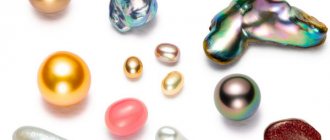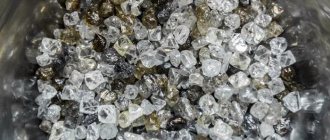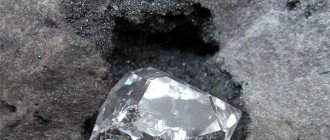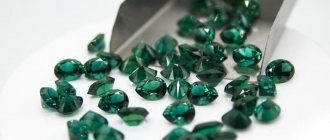Silver is number 2 in the list of precious metals after gold. Today, several methods of its extraction are known, and these technologies have significant differences with those that were used previously.
Then the rock was heated and chiseled in mortars until it was completely crushed. After this, sand washing and silver mining began on special shields covered with the skins of killed animals.
In nature, this native metal can be found much less frequently than gold, and for some time this noble metal was valued even higher than gold bars.
Next, we will tell you how silver is mined and what happens to it before it ends up in jewelry store windows.
Historical reference
Even in ancient times, people discovered silver and attributed noble meaning to it. Archaeologists, conducting excavations, have discovered silver items all over the world: Scandinavia, South America, the Middle East, etc. Silver items were also found among the ancient Egyptians before the rise of pharaohs and dynasties.
Silver was believed to have magical and healing properties. In ancient times, people believed that silver represented the Moon, and alchemists included the metal as a chemical element in their experiments.
Samples
Fineness is the percentage of pure metal in a product, alloy or ingot. The most common impurity remaining in silver items is copper.
Table 1. Application depending on purity
| Try | Products |
| 800 | Cutlery (not considered jewelry, so-called yellow) |
| 830 | Cutlery, cheap jewelry |
| 875 | Tableware, interior and jewelry |
| 925 | Jewelry and interior items, cutlery, coins, memorial signs (the most common, sterling) |
| 960 | Valuable jewelry and products (very soft, easily deformed) |
| 999 | Silver bars, solder, parts for devices (soft, difficult to process, easily deformed) |
Silver in nature
Silver metal is present in many minerals and is rarely found in its pure form. Silver is found in rocks, sulfides, shales, etc. It has been established that the metal content in the soil is 60-70 mg per ton.
However, only some ores are convenient and economical to use for the extraction of precious metals: gold-silver, copper, lead.
In addition, some mineral compounds contain silver, which can also be extracted:
- stephanite;
- polybasite;
- dyscrasite;
- electrum;
- costulitis, etc.
Sea water also contains silver elements, and there are much more of them than in the earth. But at the moment, it is impossible to carry out work in water areas due to the lack of necessary technologies and the high cost of their development.
Silver is one of the chemical elements that is found in trace amounts in living organisms but plays an important role in healthy functioning. Surprisingly, the white metal is also present in meteorites. The following are answers to the question: how is silver mined?
You may be interested in: 3 rubles St. George the Victorious made of silver – coin price
Scope of application
Chemical industry
One of the areas of silver consumption is traditionally the chemical industry. This is, first of all, special equipment designed for the production of phenol and glacial acetic acid. Also – covering a whole range of devices and their elements. Even high-grade silver pipes are manufactured to transport a number of highly aggressive liquids.
A huge number of laboratory glassware and instruments for the needs of the chemical industry contain silver. It is in it that the melting of alkalis and metal salts obtained from alkalis occurs.
Many chemical industry technologies use silver and its compounds as catalysts.
Production of contacts for various electrical products
Silver is also indispensable in the production of various electrical products. The so-called technical grade of this chemical element (999th grade) has an extremely high level of electrical conductivity, thermal conductivity and light reflection.
Wires, solders, contacts, and coatings made from this material have unique technical parameters. The list of products manufactured using silver includes many electronic elements:
- diodes, resistors, transistors, capacitors, microcircuits;
- fuses, connectors, relays, cable products.
Battery production
Modern society wants to have a high level of comfort. To ensure this, we need miniature and durable sources of electric current. Here, silver-zinc miniature batteries, which have longevity and are capable of maintaining a stable voltage level for a long time at a high level of energy intensity, fully demonstrated their advantages.
Larger silver-zinc batteries, which are worthy competitors to their acid and alkaline counterparts, have similar qualities. They are in high demand in vehicles where there is no possibility of connecting to stationary power sources.
Jewelry industry
Due to a number of its features, namely: hygiene, durability, corrosion resistance, ductility, silver has been used as jewelry since ancient times. And not only as a 925 alloy, but also in combination with many other metals.
Thus, one of the cutting-edge developments is a silver-platinum alloy of increased hardness, which contains 5% platinum and at the same time has a high level of resistance to oxidizing agents. Don’t forget about the possibility of applying silver plating to many metal products.
Photo
A quarter of the world's silver production is used for photography. Even before its invention, the unique light-sensitive properties of this precious metal were used to create images, later called daggerotypes. Subsequently, light-sensitive materials created on the basis of silver halide crystals opened up the possibility of obtaining optimal photographs in a very short time.
Silver extraction methods
Previously, the metal was found in its native form. Later it was heated in a container and crushed, and then washed on animal skins to remove sand and other contaminants. And the already purified metal was melted into ingots. At a certain period, silver was valued even more than gold itself.
Today's technology is significantly different from previous centuries.
There are several stages of mining work:
- on a plot of land that had previously been explored for the presence of silver, miners drill holes into which an explosive is later installed;
- after the explosion, the resulting pieces are removed upward;
- specialists study ore for further work;
- pieces of ore are placed in a special crusher for grinding;
- repeating the process for further division in a smaller crusher;
- crushing the resulting pieces until sand forms in a cone crusher.
Silver can currently be mined using two methods: cyanidation and amalgamation.
Cyanidation is a process in which the mined metal is exposed to oxygen and cyanide. The interaction of these two elements, which are in the form of a solution, allows the precious metal to dissolve. The liquid is then passed through special filters.
The filter walls are treated with zinc, which attracts silver molecules. But there is one drawback: 50% of the resulting layer cannot be used, as it is waste.
Amalgamation is a second method of silver mining in which the silver is exposed to mercury. When the elements come into contact, they form a wet state that needs to be removed from water.
Samples are tested in laboratories for the presence of grams of silver per kilogram of ore, and then placed in a furnace that is heated to 1000°. Next, the pieces are treated with a number of chemicals that prevent the silver from burning out, and the ore is sent back to the furnace.
After all the procedures, not only silver remains, but also some gold, as well as other metals. After filtering the resulting elements, the samples are melted into ingots.
Metal cleaning
There are other methods for extracting pure silver, for example, the pyrometallurgical method. It is used only when the concentrate is lead or copper elements.
You may be interested in: Precious metals around us: in what radio components can they be found?
Raw copper compounds are placed in an electrical bath to cause electrolysis. Copper dissolves, and silver settles to the bottom.
Raw lead is treated with zinc at a high temperature of 450 degrees. Silver tends to gravitate towards zinc and thus dissolves better. The separated layer of silver and zinc is extracted and the next task is to separate the precious metal.
A temperature of 1250° can evaporate the zinc, but the silver does not remain in its pure form: lead and arsenic are still present. But after treatment with oxygen at 1000°, silver appears in a form in which it can be melted into ingots.
It should be noted that this is a fairly profitable method of purifying metal, since lead and copper are not expensive compounds, which means their processing does not require serious financial investments.
Silver mining work in Russia
Silver mining in Russia dates back to Peter I, who allowed the search for silver burials to begin, although silver had been known in Rus' since the 10th century.
Silver reserves are located in the east of the country, so the first silver smelting plant was opened in Transbaikalia in 1701. After the reforms of Witte and Stolypin for the development of Siberia and the Far East in the 20th century, large silver deposits were discovered.
The Russian Federation is one of the world's largest industrial centers for silver mining, since the extracted metal is not only spent for its own needs, but the country also actively exports some of it. Large deposits of silver are located in the Magadan Region, Chita Region, Khabarovsk Territory, Krasnoyarsk Territory, and the Republic of Sakha.
In total, there are about 100 deposits in the country, which are located in 20 regions of the country. Silver is also mined in the North Caucasus, and in the northwestern regions, and in the Urals.
You may be interested in: Why does silver on the human body turn black and how to prevent it?
The country's largest precious metals mining company, Polymetal, processes 48% of silver annually. In 2008, the company was the absolute leader in silver mining in Russia.
In addition to the silver mining work itself, Polymetal is engaged in exploration work in search of new locations.
The technical base in this industry is constantly expanding, new scientific achievements are being used. In Russia, about 600 tons are mined per year, and in 2013 a record was set - 1,500 tons.
Silver mining work in the world
Mexico has been the undisputed leader in silver production since 2013. Only per year it extracts about 4,300 tons of metal from the bowels of the earth, which amounts to 19% of all world production.
The remaining leaders (in descending order) are:
- China;
- Peru;
- Australia;
- Russia.
There are other silver mining centers in the world: Sweden, Poland, Germany, Spain, Kazakhstan, Chile, Morocco, etc.
According to some geological data, silver reserves around the world amount to 512 thousand tons, and the annual production of silver in the world is 22 tons. The popularity of silver is due to the fact that without its participation, the operation of various gadgets and electronics is impossible. This is due to its physical and chemical properties, because 80% of silver is spent for production purposes, and only 20% goes to jewelry.
World reserves
According to information provided by the US Geological Survey, the top places in the table of the world's leading powers with the largest reserves of silver are:
- Peru and Poland. Both have about 110 thousand tons of this precious metal. There are other data: Peru – 120 thousand tons. Poland – 100 thousand tons.
- Australia – 89 thousand tons.
- China – 41 thousand tons.
- Mexico – 37 thousand tons.
- Chile – 26 thousand tons.
- USA – 25 thousand tons.
There are no data for the Russian Federation, although according to estimates by a number of experts, the proven reserves of this mineral in our country are about 70 thousand tons (according to other sources, they are estimated at 45 thousand tons). It is clear that it is not possible to accurately calculate underground reserves.











